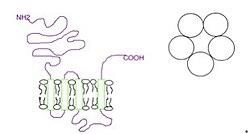5-HT3 receptor
[1][2][3] This ion channel is cation-selective and mediates neuronal depolarization and excitation within the central and peripheral nervous systems.Binding of the neurotransmitter 5-hydroxytryptamine (serotonin) to the 5-HT3 receptor opens the channel, which, in turn, leads to an excitatory response in neurons.The 5-HT3C, 5-HT3D and 5-HT3E genes tend to show peripherally restricted pattern of expression, with high levels in the gut.The 5-HT3 receptor is expressed throughout the central and peripheral nervous systems and mediates a variety of physiological functions.[14] On a cellular level, it has been shown that postsynaptic 5-HT3 receptors mediate fast excitatory synaptic transmission in rat neocortical interneurons, amygdala, and hippocampus, and in ferret visual cortex.


Cys-loop superfamilyligand-gated ion channels5-HT receptorsserotoninG protein-coupled receptorscationcentralperipheralnervous systemssodiumpotassiumcalciumneurotransmitteranionsnicotinic acetylcholine receptor5-HT receptorG-protein-coupled5-HT3Aion channelextracellulartransmembraneagonistscompetitive antagonistscell membranechromosomes 11gene duplicationspathophysiologicalintronsα7-acetylcholine receptorduodenumstomachchemotherapeuticpolymorphism5-HTR3B receptorbiomarkerperipheral nervous systemsamygdalavisual cortexbrain stemnociceptiveemesisCereulide2-methyl-5-HTAlpha-MethyltryptamineBufoteninChlorophenylbiguanideEthanolIbogainePhenylbiguanideQuipazineRS-56812SR-57227VareniclineYM-31636CGS-12066A5-HT3 antagonistAntiemeticsAS-8112GranisetronOndansetronTropisetronGastroprokineticsAlosetronBatanoprideMetoclopramideRenzaprideZacopridemosaprideAntidepressantsBupropionMianserinMirtazapineVortioxetineAntipsychoticsClozapineOlanzapineQuetiapineAntimalarialsQuinineChloroquineMefloquineCannabidiol (CBD)Delta-9-TetrahydrocannabinolLamotrigineepilepsybipolar disorderMemantineAlzheimer's diseaseMentholThujoneIndoleAnaestheticsChloroformHalothaneIsofluranechemotherapyradiotherapyvomiting5-HT3 receptor antagonists5-HT1 receptor5-HT2 receptor5-HT4 receptor5-HT5 receptor5-HT6 receptor5-HT7 receptorBibcodeSpringer-VerlagMedical Subject Headingscell surface receptorCys-loop receptors5-HT/serotoninGABAA-ρGlycineNicotinic acetylcholine(α3)2(β4)3(α4)2(β2)3(α7)5(α1)2(β4)3 - Ganglion type(α1)2β1δε - Muscle typeZinc-activatedIonotropicglutamatesKainatePurinergic receptorsSerotonin receptormodulators